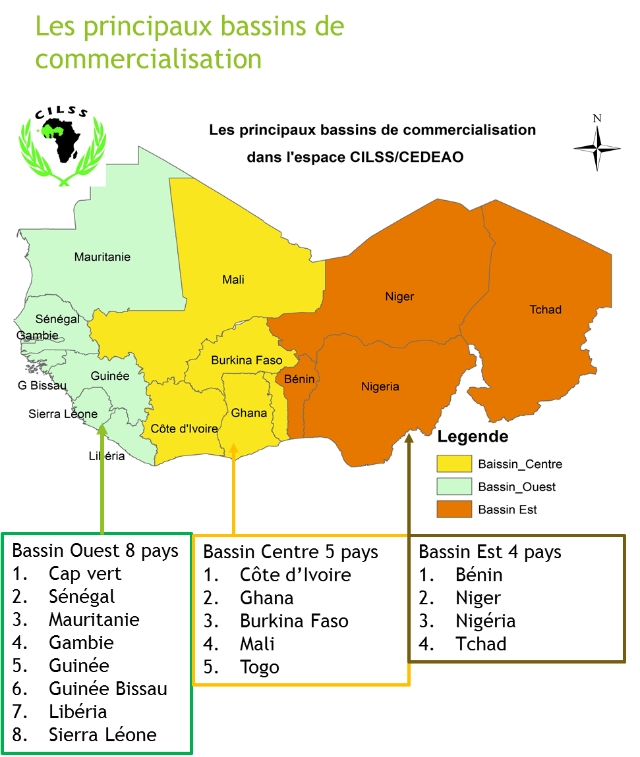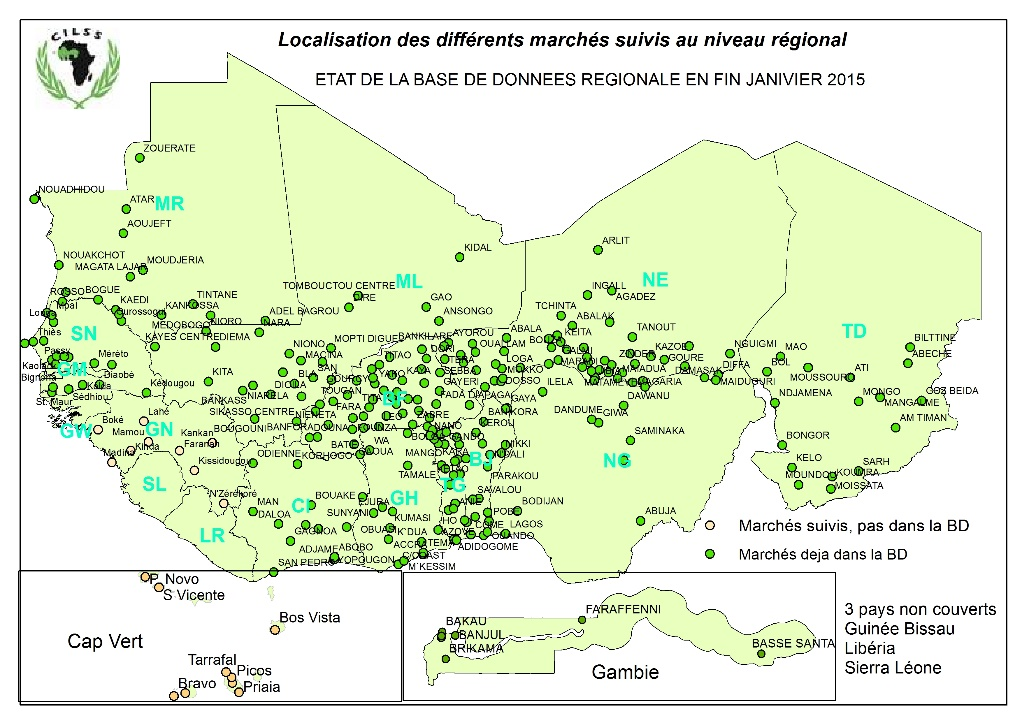 --
AGRICULTURAL MARKETS
--
AGRICULTURAL MARKETS
|
|
Under the Agricultural Markets System
In the region, agricultural markets are monitored through National Market Information Systems (MIS), joint market assessment missions, etc..
National Market Information Systems
Market Information Systems (MIS) are key elements of the food security system at national and regional levels. MIS are now present in all CILSS countries but at different levels of functioning. Most of them came from the wave of economic liberalization that began in the 1980s with the end of state monopolies on trade, the redefinition of the role of the Cereal Offices and the abandonment of price control policies. The primary objectives of the MIS are to :- Contribute to improving the functioning of the market by better informing actors with a view to strengthening the bargaining power of producers, broadening consumer choices and enabling traders to ensure better circulation of cereals;
- Improving knowledge of the market at the level of the policy-makers of the cereal policy, with a view to rationalizing the actions of the State, the cereal boards and the donors. They make available market data (prices, offers, stocks) and also analyzes markets and food situation through weekly, monthly, quarterly and cyclical bulletins.
Joint market assessment missions
The joint mission was set up following a food crisis in 2005. In 2006, a WFP-FEWS NET and CILSS meeting was organized in Ouagadougou, Burkina Faso, to set up a mechanism One-off collection of information in order to get the SIM to collect this information permanently in order to anticipate responses to crises through analysis of market dysfunction. The results of these missions are essential for understanding the functioning of mid-marketing markets

Joint missions traverse the marketing basins of the regions: the western basin; Basin center and basin is (map) and they visit a panel of key markets. These are rapid surveys through interviews and focus groups with key actors in agropastoral markets. These missions usually take place during the first half of February and depending on the nature of the campaign, a second joint mission takes place between May and June. Country reports are compiled into a "basin" report and a regional synthesis is produced. The results of these missions serve to feed the PREGECs of March and that of June.
Partner information :
- The Fews Net collection system ;
- The Food Price Index of FAO
The CILSS Regional Market Database
The regional market database for the agropastoral markets currently includes more than 300 markets in the 17 countries of space (map). More than forty products are regularly monitored and group CILSS :
- Cereals: maize, sorghum, rice, millet, wheat, fonio ;
- Legumes: groundnut, cowpea, voandzou, soya ;
- Oilseeds :
- Roots and tubers: cassava, yam, potato, potato
- Fruits and vegetables: plantain, onion
- Cattle on feet: cattle, sheep, goats, asins, camelin
- MARKET :Physical (geographic) place recognized as such where supply and demand are met
- Collection market :market where most of the supply is supplied by producers to the collectors,
- Grouping market :place where most of the supply is provided by the collectors to the aggregators,
- Wholesale market :place where most of the supply is provided by aggregators to wholesalers,
- Consumer market :place where most transactions take place between traders and consumers,
- Border market :market located at a border,
- Cross-border/regional market:market where most transactions are carried out between actors from several countries.
- Producers
- Merchants
- collectors / intermediaries
- wholesalers and semi-wholesalers
- retailers and
- consumers
- Other actors : transporters, processors
- the typology of prices
- Producer price :price at which the producer sells his product after discussion
- Aggregation price :price at which the collector sells his product after transaction
- Wholesale price :price at which the wholesaler sells his product to semi-wholesalers and retailers
- Retail/consumer price :price at which the consumer buys the product
- Cereals :maize, sorghum, millet, rice and fonio, wheat
- Legumes :cowpea, peanut, wouandzou, soya, pea, lentil
- Oilseeds :sesame, palm nuts, cashew nuts, shea
- Roots and tubers:cassava, yam taro, sweet potato, potato
- Vegetables :cabbage, cucumber, tomato, squash, courgette, lettuce, onion, pepper, okra, eggplant, shallot, garlic, green bean, pepper, etc....
- Fruits: orange, banana, mango, watermelon, pineapple, lemon, mandarin, cola, ginger, grapefruit, guava, dates, monkey bread
- Fish products: fish, crustaceans
- Hoofed livestock :cattle, sheep, goats, camel, donkeys, horses, poultry
- Meat and chicken:bovine, ovine, caprine, camel,equine, poultry
- Milk and cheese
- Others: honey, milk, eggs, snails.......
- Offer:quantity presented on the market
- Demand :needs expressed by users in quantity and quality
- Provenance :place of purchase of the product.
- Imported product:product that comes from a neighbouring or distant country.
- Origine : lieu de production du produit
- Origin : place of production of the product
- Destination : place of transport of the product
The regional database on agropastoral markets and sectors aims to make available to market actors (politicians, regional analysts) the information needed to promote trade in agro-food products in the Sahel and in Africa from West.
The database is specifically to:
Monitor the impacts of policies to support food chains;Analyze structural and cyclical food security using the harmonized framework, the food balance sheet;
Supply the management system of the regional food security reserve.
Concepts et définitions
Typologies
Market actors
The main products monitored by the MISs
FLUX :movement of physical products from one point to another
Location maps of the main markets monitored
























